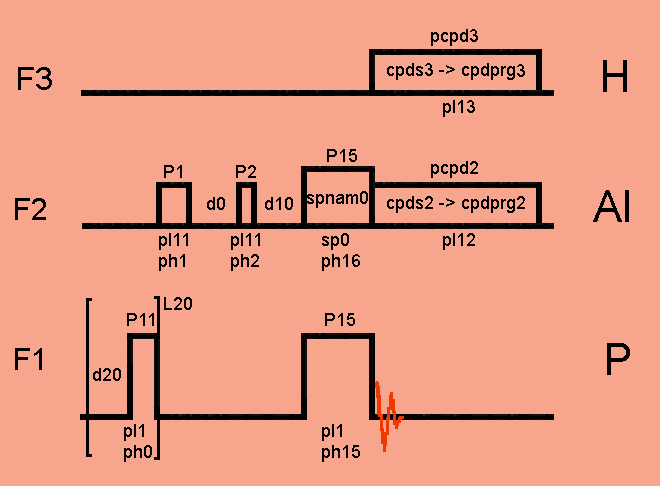
3Q HETCOR pulse program for topSpin2.1 operating system and spin I = 5/2, 7/2 and 9/2 systems

;mqhetcor (TOPSPIN 2.0) ; 3Q HETCOR experiment for spin-5/2, spin-7/2, and spin-9/2 nuclei ; 3Q in the indirect dimension for the quadrupole nucleus ; MAS in the direct dimension for the spin-1/2 nucleus ; uses a saturation pulse train on the spin-1/2, which is important ; if T1 of spin-1/2 is long ; written by Stefan Steuernagel (031201) ; adapted to Bruker convention from the original version of Christian Fernandez ;Avance II+ version ;parameters: ;ns : 48 * n ;d1 : recycle delay, acc. to T1 of spin-5/2 ;d20 : delay in saturation pulse train ;l20 : # of pulses in saturation pulse train ;pl1 : spin-1/2 power level for CP and 90 degree pulses ;pl11 : power level for Al excitation and conversion pulses ;pl2 : =119 dB, not used ;pl3 : =119 dB, not used ;pl12 : power level used in cw, tppm15, or pidec12 ;pl13 : power level used in cw13, tppm13, or pidec13 ;sp0 : spin-n/2 power level for CP ;cpdprg2 : decoupling sequence for quadrupole nucleus ;cpdprg3 : optional decoupling for 3rd nucleus ;p1 : 3Q excitation pulse ;p2 : 3Q conversion pulse ;p11 : spin-1/2 90 degree pulse at pl1 ;p15 : contact time ;pcpd2 : pulse length in f2 decoupling sequence ;pcpd3 : pulse length in f3 decoupling sequence ;spnam0 : square.100, to use ramp is not recommended here ;d0 : =1u or longer ;cnst10 : =19/12 (I=5/2), =101/45 (I=7/2), =91/36 (I=9/2) ;d10 : =d0*cnst10, incremented within pulse program ;in0 : 1 rotation period for synchronised experiment ;in0 = inf1 ;td1 : number of t1-experiments ;FnMODE : States ;zgoptns : -Dpidec, or -Dxix ;$COMMENT=3Q HETCOR (CP based) between spin-1/2 and spin-5/2, -7/2, or -9/2 ;$CLASS=Solids ;$DIM=2D ;$TYPE=half integer quadrupoles ;$SUBTYPE=heteronuclear correlation ;$OWNER=Bruker # ifdef xix "pcpd=(1s*l31)/cnst31+p29" ;p29 : 5 - 10 us, to avoid exact rotor synchronisation # endif /* xix */ # ifdef pidec "d30=1s/cnst31-p22" ;p22 : 180 degree pulse for pi-pulse decoupling # endif /* pidec */ ;cnst11 : to adjust t=0 for acquisition, if digmod = baseopt "acqt0=1u*cnst11" 1 ze 2 d1 do:f3 do:f2 "d10=d0*cnst10" saturate, d20 (p11 pl1 ph0):f1 lo to saturate times l20 (p1 pl11 ph1):f2 d0 (p2 ph2):f2 d10 (p15 pl1 ph15):f1 (p15:sp0 ph16):f2 (1u cpds2):f2 (1u cpds3):f3 go=2 ph31 3m do:f3 do:f2 10m mc #0 to 2 F1PH(ip1,id0) exit ph0= 0 ph1=(12) {0 2 4 6 8 10}*4 {2 4 6 8 10 0}*4 ph2= {0}*6 {1}*6 {2}*6 {3}*6 ph16= 1 3 ph15= 0 ph31= {0}*24 {2}*24